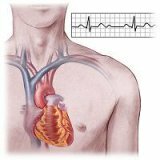Bradycardia, symptoms and treatment

The work of the heart, in which there are only 60 or fewer blood shocks per minute, is treated in medicine as a bradycardia. With normal functionality, the number of contractions of the heart muscle should be at the level of 70-90 beats per minute, however, a similar rhythm of 45-60 contractions was found in quite healthy people.
The main indicators of heart efficiency are:
- ideal reduction from 70 beats per minute to 90;
- bradycardic( low heart beat) less than 60 strokes;
- tachycardia( increased heartbeat) more than 90 beats per minute.
An ideal condition for the operation of all human systems is the contraction of the heart within 80 beats per minute.
With increased body temperature, the rhythm can increase by 10 beats, which is quite natural. With infection of the body, rapid heart work is not observed, which is a bradycardia of a relative order. However, with a clear discrepancy of high blood pressure to rare heartbeats, the diagnosis is quite certain and the bradycardia becomes the first on suspicion.
Cardiologists distinguish two types of heart rate abnormalities:
Sinus bradycardia. With a deficiency of thyroid hormones or an excess of bile cells in the blood of a person, the automation of the sinus node may noticeably decrease. Also, the cause of this can be dystrophy( or thinning), inflammation or sclerotic process of the heart muscle.
A bradycardia with a conduction disorder may also be of a sinus character. For example, this may be the case if the pulse output is slowed or disturbed from the sinus-atrial node to the atrium. And maybe heterotopic with a complete atrioventricular blockade, as a result of which there is a decrease in the rhythm of contractions.
How does the bradycardia manifest?
The occurrence of rapid heart rhythm in a dream in athletes or at high physical exertion is not uncommon, but some diseases cause heart malfunction.
The bradycardia of the vagotonic character often becomes a consequence of disturbance of the vegetative-vascular system of a person and neuroses. With increased ICP, as well as with acute jaundice, there is a risk of reducing the frequency of contraction of the heart muscle.
Manifestation of bradycardia or alternation of bradycardia - tachycardia( tachy-brady syndrome) can have a basis on partial damage to the sulphone node. Usually, this is clearly seen in patients who have myocardial dystrophy or myocarditis. Cardiosclerosis, by the way, can be attributed to the same risk group, which leads to a decrease in the conduction of the main cardiac muscle.
Disturbances in geodynamics are not noticeable when the patient has moderate bradycardia. Symptoms, in this case, are blurred.
However, the development of heart failure is possible with a sharp decrease to 40 beats / min. Contractions of the heart muscles, bradycardia based on severe myocardial damage or with a pronounced tachy-brady syndrome.
Any manifestation of heart rhythm disturbance requires mandatory diagnosis with the use of ECG data. And when observing a periodic disturbance, you should use a special device and conduct a long-term measurement of the heart's work with the subsequent appointment of treatment. Observing all these simple rules, your doctor will be able to determine the symptoms and treatment of bradycardia in time.
What could be the reason for heart rhythm disturbance?
It is the electrical impulses coming from the sinus node that cause the muscles to contract. If impulse propagation is impaired, negative changes occur in the conduction system of the heart. However, the failure of the sinus node itself can cause weak heart work( bradycardia), as well as tachycardia or even arrhythmia.
Myocarditis, ischemia, or atherosclerosis of blood vessels can give impetus to the instability of cardiac muscle work.
Nervous and endocrine system, severe infectious diseases or increased cranial pressure - all these are interrelated processes that, when activity is disrupted, have a direct impact on the heart and its functional functionality.
But it is worth repeating that the cause of bradycardia does not necessarily have to be pathological diseases. The beaten heart rate is also found in healthy people.
Different drugs often have a list of side effects the occurrence of rapid heart work. On this, of course, always worth paying attention to. Even a single intake of the drug can play a cumulative effect in the human body.
The lack of fresh air( hypoxia), a closed space without ventilation, has an extremely negative effect on the human body and can, sooner or later, push the development of a bradycardia.
Bradycardia, symptoms and treatment of the disease.
Symptoms of bradycardia include loss of consciousness when heart rate slows. Instability of blood pressure or hypertension, high fatigue and poor state of health from excessive physical exertion can also be regarded as signs of a failure in the rhythm of contraction.
Insufficiency of blood circulation in both circles( small and large), angina of rest or tension similarly manifest with bradycardia and can cause the patient to register for disability.
For the diagnosis of early or acute bradycardia, ECG monitoring is used to describe the work of the heart at a specific time( if the cardiogram is done for a long time) or in a few minutes of captured functionality.
And for the treatment of the disease the first recommendation from a doctor can be obtained: "It is necessary to treat not only the disease itself, but also compensate its body - restore the rhythm of heartbeats."
Basically bradycardia and treatment of this disease is medicamentous with good recovery rates, and in cases of more neglected, operatively, a special pacemaker is installed, which independently supports the proper operation of the heart.
Early diagnosis and timely treatment measures will help to get rid of many problems associated with abnormal rhythm of contractions. The heart is the main organ in the human body. And it should be healthy!



